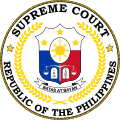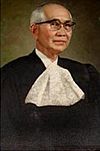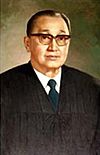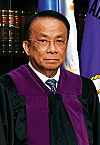Chief Justice of the Supreme Court of the Philippines facts for kids
Quick facts for kids Chief Justice of the Philippines |
|
|---|---|

Flag of the Supreme Court
|
|

Seal of the Supreme Court
|
|
| Style | The Honourable (formal) Your Honour (when addressed directly in court) |
| Member of |
|
| Appointer | Presidential appointment upon nomination by the Judicial and Bar Council |
| Term length | Retirement at the age of 70 |
| Inaugural holder |
|
| Formation | June 11, 1901 |
| Website | Official Website: http://sc.judiciary.gov.ph/ |
The Chief Justice of the Philippines (called Punong Mahistrado ng Pilipinas in Filipino) is a very important person in the Philippine government. They lead the Supreme Court of the Philippines, which is the highest court in the country. Think of them as the top judge!
As of April 5, 2021, Alexander Gesmundo holds this position. He was chosen by President Rodrigo Duterte. The Chief Justice job is one of the oldest government roles in the Philippines that has always been held by a Filipino. It started on June 11, 1901, with Cayetano Arellano. This was even before the President or Vice President roles were created!
Contents
What Does the Chief Justice Do?
The Chief Justice has many important duties. They help make sure justice is served fairly in the Philippines.
How is the Chief Justice Chosen?
The president of the Philippines chooses the Chief Justice. The president picks from a list of three people. This list is made by the Judicial and Bar Council. This council helps find the best people for judge roles.
Just like other judges in the Supreme Court, the Chief Justice must retire when they turn 70 years old. There is no time limit for how long they can serve before that age.
Key Responsibilities of the Chief Justice
The Chief Justice has some special roles. They lead the Judicial and Bar Council. They also lead any impeachment trial of the president. This means they are in charge if a president is accused of serious wrongdoing.
The Chief Justice also has to personally check every decision made by the Supreme Court. Even though they are the leader, they only have one vote out of 15 in the court. They are seen as the "first among equals" among the other judges.
Still, the Chief Justice has a lot of influence. People often connect the Supreme Court to the Chief Justice who is serving at the time. For example, people might say "The Fernando Court" to talk about the court when Enrique Fernando was Chief Justice.
Swearing in the President
It is a tradition for the Chief Justice to swear in the new president of the Philippines. This means they lead the ceremony where the president takes their oath of office.
However, this tradition has been broken a few times. In 1986, Corazon Aquino took her oath before an Associate Justice, not the Chief Justice. This happened because of special political events. Later, in 2010, Benigno Aquino III also chose an Associate Justice to swear him in. In 2016, Rodrigo Duterte was sworn in by an Associate Justice who was his classmate.
The Chief Justice also chooses three judges from the Supreme Court. These judges join special groups that handle election disputes in the House of Representatives and the Senate.
Overall, the Chief Justice is the main leader of the entire Philippine court system. They, along with the Supreme Court, oversee all courts and their staff.
Who Has Been Chief Justice?
Here is a list of the people who have served as Chief Justice of the Philippines.
| No. | Image | Chief Justice | Time in Office | Appointed by | Law School | Prior Office |
|---|---|---|---|---|---|---|
| 1 |  |
Cayetano Arellano (1847–1920) |
June 15, 1901 – April 12, 1920 (Resigned) |
William McKinley | UST | President of the Supreme Court (1899–1901) |
| 2 |  |
Victorino Mapa (1855–1927) |
July 1, 1920 – October 31, 1921 (Resigned) |
Woodrow Wilson | Secretary of Justice (1913–1920) Associate Justice of the Supreme Court (1901–1913) |
|
| 3 |  |
Manuel Araullo (1853–1924) |
November 1, 1921 – July 26, 1924 (Died) |
Warren G. Harding | Associate Justice of the Supreme Court (1913–1921) |
|
| 4 |  |
Ramon Avanceña (1872–1957) |
April 1, 1925 – December 24, 1941 (Resigned) |
Calvin Coolidge | Associate Justice of the Supreme Court (1917–1925) |
|
| 5 |  |
Jose Abad Santos (1886–1942) |
December 24, 1941 – May 1, 1942 (Died) |
Manuel L. Quezon | Northwestern | Associate Justice of the Supreme Court (1932–1941) |
| 6 |  |
Jose Yulo (1894–1976) |
May 7, 1942 – July 9, 1945 (Resigned) |
Masaharu Homma | UP | Speaker of the National Assembly (1939–1941) |
| 7 |  |
Manuel Moran (1893–1961) |
July 9, 1945 – March 20, 1951 (Resigned) |
Sergio Osmeña | Escuela de Derecho | Associate Justice of the Supreme Court (1938–1945) |
| 8 |  |
Ricardo Paras (1891–1984) |
April 2, 1951 – February 17, 1961 (Retired) |
Elpidio Quirino | UP | Associate Justice of the Supreme Court (1941–1951) |
| 9 |  |
Cesar Bengzon (1896–1992) |
April 28, 1961 – May 29, 1966 (Retired) |
Carlos P. Garcia | Associate Justice of the Supreme Court (1945–1961) |
|
| 10 |  |
Roberto Concepcion (1903–1987) |
June 17, 1966 – April 18, 1973 (Retired) |
Ferdinand Marcos | UST | Associate Justice of the Supreme Court (1954–1966) |
| 11 |  |
Querube Makalintal (1910–2002) |
October 21, 1973 – December 22, 1975 (Retired) |
Ferdinand Marcos | UP | Associate Justice of the Supreme Court (1962–1973) |
| 12 |  |
Fred Ruiz Castro (1914–1979) |
January 5, 1976 – April 19, 1979 (Died) |
Ferdinand Marcos | Associate Justice of the Supreme Court (1966–1976) |
|
| 13 |  |
Enrique Fernando (1915–2004) |
July 2, 1979 – July 24, 1985 (Retired) |
Ferdinand Marcos | Associate Justice of the Supreme Court (1967–1979) |
|
| 14 |  |
Felix Makasiar (1915–1992) |
July 25, 1985 – November 19, 1985 (Retired) |
Ferdinand Marcos | Associate Justice of the Supreme Court (1970–1985) |
|
| 15 |  |
Ramon Aquino (1917–1993) |
November 20, 1985 – March 6, 1987 (Resigned) |
Ferdinand Marcos | Associate Justice of the Supreme Court (1973–1985) |
|
| 16 |  |
Claudio Teehankee (1918–1989) |
April 2, 1987 – April 18, 1988 (Retired) |
Corazon Aquino | Ateneo | Associate Justice of the Supreme Court (1969–1987) |
| 17 |  |
Pedro Yap (1918–2003) |
April 19 – June 30, 1988 (Retired) |
Corazon Aquino | UP | Associate Justice of the Supreme Court (1986–1988) |
| 18 |  |
Marcelo Fernan (1927–1999) |
July 1, 1988 – December 6, 1991 (Resigned) |
Corazon Aquino | Associate Justice of the Supreme Court (1986–1988) |
|
| 19 |  |
Andres Narvasa (1928–2013) |
December 8, 1991 – November 30, 1998 (Retired) |
Corazon Aquino | UST | Associate Justice of the Supreme Court (1986–1991) |
| 20 |  |
Hilario Davide Jr. (born 1935) |
November 30, 1998 – December 20, 2005 (Retired) |
Joseph Estrada | UP | Associate Justice of the Supreme Court (1991–1998) |
| 21 |  |
Artemio Panganiban (born 1936) |
December 20, 2005 – December 7, 2006 (Retired) |
Gloria Macapagal Arroyo | FEU | Associate Justice of the Supreme Court (1995–2005) |
| 22 |  |
Reynato Puno (born 1940) |
December 7, 2006 – May 17, 2010 (Retired) |
Gloria Macapagal Arroyo | UP | Associate Justice of the Supreme Court (1993–2006) |
| 23 |  |
Renato Corona (1948–2016) |
May 17, 2010 – May 29, 2012' (Removed from office) |
Gloria Macapagal Arroyo | Ateneo | Associate Justice of the Supreme Court (2002–2010) |
| – |  |
Maria Lourdes Sereno (born 1960) |
August 25, 2012 – May 11, 2018 (Term later declared invalid) |
Benigno Aquino III | UP | Associate Justice of the Supreme Court (2010–2012) |
| 24 |  |
Teresita de Castro (born 1948) |
August 28 – October 10, 2018 (Retired) |
Rodrigo Duterte | Associate Justice of the Supreme Court (2007–2018) |
|
| 25 |  |
Lucas Bersamin (born 1949) |
November 26, 2018 – October 18, 2019 (Retired) |
Rodrigo Duterte | UE | Associate Justice of the Supreme Court (2009–2018) |
| 26 |  |
Diosdado Peralta (born 1952) |
October 23, 2019 – March 27, 2021 (Resigned) |
Rodrigo Duterte | UST | Associate Justice of the Supreme Court (2009–2019) |
| 27 |  |
Alexander Gesmundo (born 1956) |
April 5, 2021 – present | Rodrigo Duterte
|
Ateneo | Associate Justice of the Supreme Court (2017–2021) |
- José Abad Santos could not lead the Supreme Court because of World War II.
- Renato Corona was removed from his position on May 29, 2012, after a trial.
- Maria Lourdes Sereno was the first woman appointed as Chief Justice. However, her appointment was later declared invalid by the court. This means her time in office is not officially counted. Because of this, Teresita de Castro became the first officially recognized female Chief Justice.
Acting Chief Justices
Sometimes, a Senior Associate Justice steps in as "Acting Chief Justice" for a short time. This happens when there is no Chief Justice in office yet. Here are some who have served in this temporary role:
| Senior Associate Justice | Year Appointed | Term as AJ | Tenure as Acting Chief Justice | |
|---|---|---|---|---|
| Florentino Torres | 1901 | 1901-1920 | April 1, 1920 | April 20, 1920 |
| Elias Finley Johnson | 1903 | 1903-1933 | April 20, 1920 | July 1, 1920 |
| October 31, 1921 | November 1, 1921 | |||
| July 26, 1924 | April 1, 1925 | |||
| José Abad Santos | 1932 | 1932-1941 | December 24, 1941 | |
| Manuel V. Moran | 1938 | 1938-1945 | May 1, 1942 | May 7, 1942 |
| Ricardo M. Paras Jr. | 1941 | 1941-1951 | March 20, 1951 | April 2, 1951 |
| César F. Bengzon | 1945 | 1945-1961 | February 17, 1961 | April 28, 1961 |
| Roberto R. Concepcion | 1954 | 1954-1966 | May 29, 1966 | June 17, 1966 |
| Querube C. Makalintal | 1962 | 1962-1973 | April 18, 1973 | October 21, 1973 |
| Fred Ruiz Castro | 1966 | 1966-1975 | December 22, 1975 | January 5, 1976 |
| Enrique M. Fernando Sr. | 1967 | 1967-1979 | April 19, 1979 | July 2, 1979 |
| Claudio Teehankee Sr. | 1968 | 1979-1986 | July 24, 1985 | July 25, 1985 |
| November 19, 1985 | November 20, 1985 | |||
| March 6, 1987 | April 1, 1987 | |||
| Ameurfina Melencio-Herrera | 1979
1986 (reappointed) |
1979-1992 | April 18, 1988 | April 19, 1988 |
| June 30, 1988 | July 1, 1988 | |||
| December 6, 1991 | December 8, 1991 | |||
| Flerida Ruth P. Romero | 1991 | 1991-1999 | November 30, 1998 | |
| Reynato S. Puno | 1993 | 1993 | December 20, 2005 | |
| Leonardo A. Quisumbing | 1998 | 1998-2009 | December 7, 2005 | |
| Antonio T. Carpio | 2001 | 2001-2019 | May 17, 2010 | |
| May 28, 2012 | August 25, 2012 | |||
| May 11, 2018 | August 28, 2018 | |||
| October 10, 2018 | November 28, 2018 | |||
| October 17, 2019 | October 23, 2019 | |||
| Estela M. Perlas-Bernabe | 2011 | 2011-2022 | March 27, 2022 | April 5, 2022 |
Interesting Facts About Chief Justices
Many Chief Justices have had interesting careers and records.
- Longest Time in Office: Cayetano Arellano served for almost 19 years! He was Chief Justice from 1901 to 1920. He was also the oldest Chief Justice while in office, at 73 years old when he resigned.
- Shortest Time in Office: Teresita de Castro served for only 43 days. She retired soon after being appointed because she reached the age of 70. Before her, Pedro Yap held the record for the shortest term, serving for 73 days.
- Oldest to be Appointed: Teresita de Castro was almost 70 years old when she became Chief Justice in 2018.
- Youngest to be Appointed: Manuel Moran was the youngest to become Chief Justice. He was 51 years old when he was appointed.
- Longest Living: César Bengzon lived to be 96 years old, making him the longest-lived Chief Justice.
- First Female Chief Justice: Maria Lourdes Sereno was the first woman to be appointed Chief Justice. However, her appointment was later declared invalid. This means Teresita de Castro became the first officially recognized female Chief Justice.
Timeline of Chief Justices
This timeline shows when each Chief Justice served.

See also
- Associate Justice of the Supreme Court of the Philippines
- Supreme Court of the Philippines
- Constitution of the Philippines
- Justices of the Supreme Court of the Philippines





